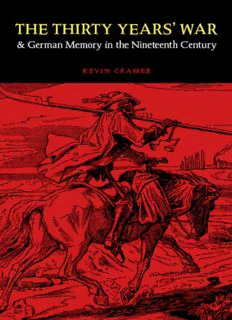
The Thirty Years' War and German Memory in the Nineteenth Century (Studies in War, Society, and the Militar) PDF
Preview The Thirty Years' War and German Memory in the Nineteenth Century (Studies in War, Society, and the Militar)
The Thirty Years’ War and German Memory in the Nineteenth Century Studies in War, Society, and the Military general editors Peter Maslowski University of Nebraska–Lincoln David Graff Kansas State University Reina Pennington Norwich University editorial board D’Ann Campbell Director of Government and Foundation Relations, U.S. Coast Guard Foundation Mark A. Clodfelter National War College Brooks D. Simpson Arizona State University Roger J. Spiller George C. Marshall Professor of Military History U.S. Army Command and General Staff College (retired) Timothy H. E. Travers University of Calgary Arthur Waldron Lauder Professor of International Relations University of Pennsylvania Kevin Cramer The Thirty Years’ War and German Memory in the Nineteenth Century University of Nebraska Press • Lincoln & London A version of chapter 2 previously appeared as “The Cult of Gustavus Adolphus: Protestant Identity and German Nationalism” in Protestants, Catholics, and Jews in Germany, 1800–1914, ed. Helmut Walser Smith (Oxford uk: Berg, 2001). © 2007 by the Board of Regents of the University of Nebraska All rights reserved Manufactured in the United States of America ∞ Library of Congress Cataloging-in- Publication Data Cramer, Kevin. The Thirty Years’ War and German memory in the nineteenth century / Kevin Cramer. p. cm. — (Studies in war, society, and the military) Includes bibliographical references and index. isbn-13: 978-0-8032-1562-7 (cloth : alk. paper) isbn-10: 0-8032-1562-2 (cloth : alk. paper) 1. Germany—History—19th cen- tury—Historiography. 2. Collective memory—Germany 3. National characteristics, German—Histo- riography. 4. Thirty Years’ War, 1618–1648—Social aspects—Ger- many. I. Title. dd203.c74 2007 943'.07—dc22 2006039637 Set in Sabon. To my mother, Mary Helen Lewis Cramer, with love and gratitude Contents Acknowledgments ix Introduction 1 1. The Great War 18 2. The War of Protestant Liberation 51 3. Wallenstein's Revolution 94 4. The Martyrdom of Magdeburg 141 5. German Gothic 178 Conclusion 217 Notes 233 Bibliography 315 Index 371 Acknowledgments Since this is a book about war, memory, and place, I think I should begin by acknowledging the profound influence my childhood had on the conceptual origins of this study. Although I was born in Michigan, I grew up in Stone Mountain, Georgia, in the 1960s and 1970s when the town was being steadily absorbed into the vast sprawl of Atlanta, the self-declared capital of the “New South.” The growth of Atlanta as a major American city meant, among other things, the gradual effacement of the more visible marks the Civil War had left on the north Georgia landscape. Yet traces remained. Backyards were marked by slowly erod- ing lines of fortifications. At many an intersection, cast-iron signs com- memorated the battles, skirmishes, and cavalry raids of the Battle of Atlanta in 1864. Every spring on Confederate Memorial Day, across from the gas station where I worked as a teenager, the small cemetery blossomed with miniature Stars and Bars placed on veterans’ graves. Blasted into the side of the most visible natural landmark in the area, the massive granite monolith that gave Stone Mountain its name, was a huge bas-relief sculpture of Robert E. Lee, Stonewall Jackson, and Jefferson Davis on horseback. A frequent destination of elementary school field trips was the Cyclorama in Grant Park Zoo that depicted the Battle of Atlanta. The memory of the Civil War was an inescapable presence. Even on the playground, lingering animosities of the war man- ifested themselves when my friends good-naturedly declared a sharp line of demarcation between those born in the South, “Rebels,” and those unfortunates like myself, “Yankees,” who, through no fault of their own, had come into the world north of the Mason-Dixon Line. Suffice it to say, as I began exploring how Germans had refought the Thirty Years’ War in the nineteenth century, I immediately recognized the preoccupation with a past that would not pass. That moment of recognition was the beginning of this book. Many people made this book possible. I owe my wife, Linda Santoro
Description: